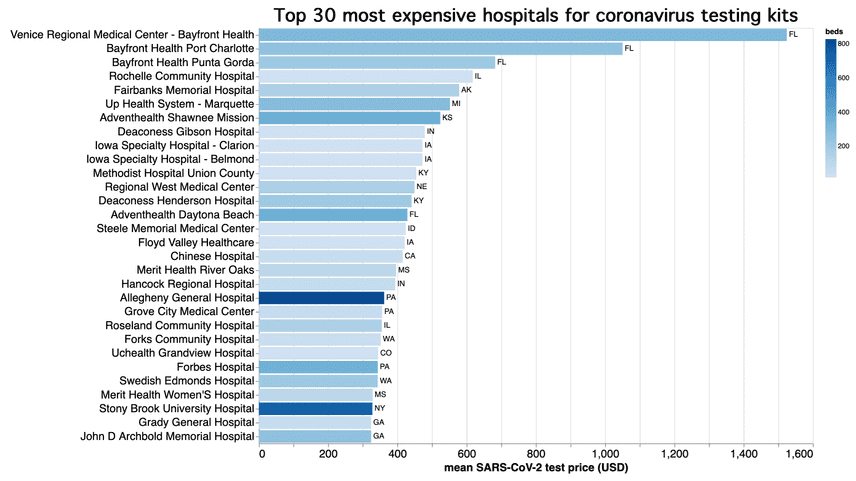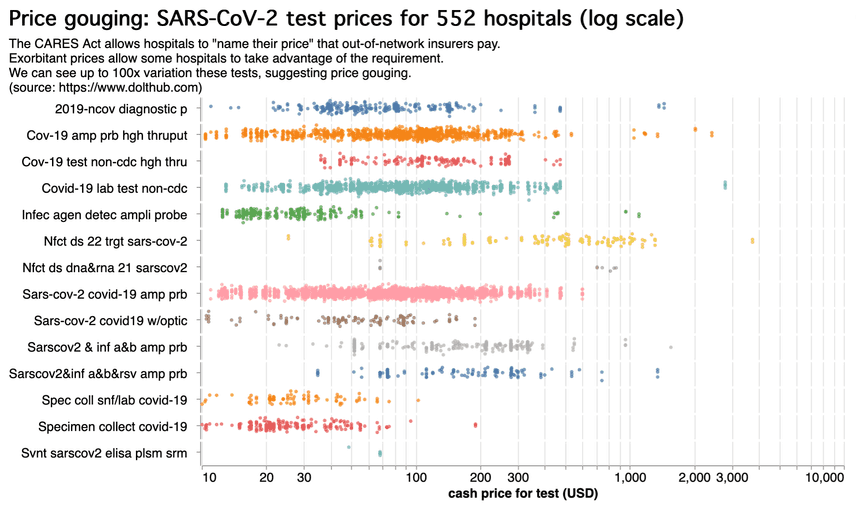What hospitals charge when your insurance can't say no
How hospitals price-gouged insurance companies during the COVID-19 pandemic
What happens when your insurance company gets a price that it can't refuse?
And how can this even happen? Aren't insurance companies notorious for turning down hospital bills?
This is part of an ongoing series on hospital prices, where we dig deep into the world's largest open hospital price database — one that we built here on DoltHub with a budget of $15k. The data we collected spans over 1800 hospitals.
Are you interested in joining one of our data bounties? We have opportunities every 6-8 weeks and a budget of $10-15k. See https://www.dolthub.com/bounties for our active bounties. For other questions come find us on Discord. https://discord.gg/tTwYVraPDM
Good artists copy. Great artists steal
I made a Google Colab notebook that allows you to reproduce everything here.
Those new to python, polars, and Altair are encouraged to learn from it. Run this notebook and modify our charts or even run your own analysis.
Insurance companies typically control hospital prices
Hospitals and insurance companies negotiate rates to come to an agreement. In theory a hospital can charge $100,000 for an ankle splint, but your insurance company can refuse to foot the bill. You'd probably end up at an "in-network" hospital — that is, one your insurance company has an agreement with already. The hospital with the $100,000 splint simply won't get your business, unless you elect to go there, aware of the increase in cost.
But what if the insurance company couldn't say no? Then the hospital could name their price. And this actually happened last year, raising healthcare prices for everyone.
Price gouging
In 2020, the CARES Act was passed to prevent normal people from getting huge hospital bills from SARS-CoV-2 testing. You could go to any hospital, in- or out-of-network, and someone would cover the cost. The uninsured were covered by the hospitals who were reimbursed for the service. For the insured, the buck got passed to their insurance companies.
If by chance you elected to go to an out-of-network hospital (and since you weren't paying, why would you care?) then your insurance company was required by law to pay the posted "cash price" for the COVID-19 test. Which meant that the hospital could charge whatever it wanted.
While most hospitals charged a fair rate, many hospitals took advantage of the situation and milked insurance companies for as much as they could.
In for a penny, in for a pounding
To immediately reproduce the charts below, run the Google Colab notebook.
Despite having a record year of profits, some hospitals banked even more cash from charging extravagant amounts for COVID-19 tests. In our sample of 1800 hospitals around 500 posted their cash prices for tests, and of these 500 we see a large number of them charging >$1,000 for kits that cost a hundredth of that. As these tests are commodities, the prices are purely fictional, and meant to extract as much money from the insurers as possible.
On a linear scale, the outliers stand out even more. Medicare reimbursement prices — close to the "true cost" — are marked by a black dot.

We can create a mean by hospital price and identify the upper highest tiers of SARS-CoV-2 test price gouging. Here we show the top 30 hospitals (colors show hospital size):

More analysis coming soon
I got inspired to look at test kit prices after finding a range of prices for all sorts of hospital labs. At some hospitals, even a platelet count can bleed your pocketbook dry.
I suspect that we'll see these same expensive hospitals come up again when we do our follow-up analysis on lab prices. I suspect that some hospitals are systematically ripping off patients and insurers through higher lab prices. Even more strangely, insurers might even have something to gain from this. More on that next time.
Discover more: clone, fork, and play
There's plenty more to discover in our dataset of 300M hospital prices. At the bottom of the notebook, I show you how to clone the entire dataset into the notebook and work from there.

